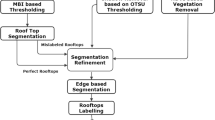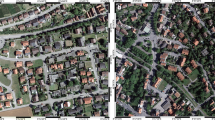Abstract
Slum areas are dense urban areas in which the building size is quite small, and the buildings are interconnected with each other. Also, there is a lot of variation in the texture of slum area buildings, which makes the extraction of individual buildings in slum areas a tough task. In this paper, a methodology has been proposed which aims to extract slum built-up areas using multispectral satellite images using MATLAB software. In the proposed methodology, two building masks have been prepared from the input image by using threshold value and Laws’ texture energy measure. After that, another building mask has been prepared by using these two masks and vegetation, non-building areas and shadow areas have been removed from it, which finally results in the detection of slum built-up areas. The proposed methodology has been applied on three subsets of QuickBird satellite image containing slum built-up areas. For accuracy assessment, the total slum area extracted from the proposed methodology has been compared with the total area obtained by manually digitized buildings. The overall accuracy of slum built-up extraction with respect to area has been found to be more than 83%. Due to resemblance of building and road texture, some over-extraction of road as slum built-up areas has also been observed in only one subset image. No over-detection has been found in other two subset images.



Similar content being viewed by others
References
Aminipouri, M., & Sliuzas, R. (2009). Object-oriented analysis of very high resolution orthophotos for estimating the population of slum areas, case of Dar-Es-Salaam, Tanzania. In Proceedings of the ISPRS XXXVIII conference.
Attarzadeh, R., & Momeni, M. J. (2018). Object-based rule sets and its transferability for building extraction from high resolution satellite imagery. Journal of the Indian Society of Remote Sensing,46(2), 169–178.
Hofmann, P. (2001). Detecting informal settlements from Ikonos image data using methods of object oriented image analysis: An example from Cape Town (South Africa). In Proceedings of the remote sensing of urban areas/regensburger geographische Schriften, Regensburg, Germany (pp. 107–118).
Hofmann, P., Strobl, J., Blaschke, T., & Kux, H. (2008). Detecting informal settlements from QuickBird data in Rio de Janeiro using an object based approach. In T. Blaschke, S. Lang, & G. J. Hay (Eds.), Object-based image analysis. Lecture notes in geoinformation and cartography. Berlin, Heidelberg: Springer.
Huang, Y., Zhuo, L., Tao, H., Shi, Q., & Liu, K. (2017). A novel building type classification scheme based on integrated LiDAR and high-resolution images. Remote Sensing,9(7), 679.
Jochem, W. C., Bird, T. J., & Tatem, A. J. (2018). Identifying residential neighbourhood types from settlement points in a machine learning approach. Computers, Environment and Urban Systems,69, 104–113.
Kit, O., & Lüdeke, M. (2013). Automated detection of slum area change in Hyderabad, India using multitemporal satellite imagery. ISPRS Journal of Photogrammetry and Remote Sensing,83, 130–137.
Kohli, D., & Sliuzas, R. (2012). An ontology of slums for image-based classification. Computers, Environment and Urban Systems,36(2), 154–163.
Kohli, D., Sliuzas, R., & Stein, A. (2016). Urban slum detection using texture and spatial metrics derived from satellite imagery. Journal of Spatial Science,61(2), 405–426.
Kuffer, M., Pfeffer, K., Sliuzas, R., & Baud, I. (2016). Extraction of slum areas from VHR imagery using GLCM variance. IEEE Journal of Selected Topics in Applied Earth Observations and Remote Sensing,9, 1830–1840.
Kuffer, M., Pfeffer, K., Sliuzas, R., Baud, I., & van Maarseveen, M. (2017). Capturing the diversity of deprived areas with image-based features: The case of Mumbai. Remote Sensing,9(4), 384.
Laws, K. (1980). Textured image segmentation. University of Southern California. Ph.D. Dissertation.
Lemma, T., Sliuzas, R., & Kuffer, M. (2006). A participatory approach to monitoring slum conditions: An example from Ethiopia. Participatory Learning and Action: Issue Based Case Studies,54, 58–66.
Leonita, G., Kuffer, M., Sliuzas, R., & Persello, C. (2018). Machine learning-based slum map** in support of slum upgrading programs: The case of Bandung City, Indonesia. Remote Sensing,10(10), 1522.
Li, J., Chapman, M., & Ruther, H. (2005). Small format digital imaging for informal settlement map**. Photogrammetric Engineering and Remote Sensing,71, 435–442.
Mason, S. O., Baltsavias, E. P., & Bishop, I. (1997). Spatial decision support systems for the management of informal settlements. Computers, Environment and Urban Systems,21, 189–208.
Niebergall, S., Loew, A., & Mauser, W. (2008). Integrative assessment of informal settlements using VHR remote sensing data—The Delhi case study. IEEE Journal of Selected Topics in Applied Earth Observations and Remote Sensing,1(3), 193–205.
Novack, T., & Kux, H. J. H. (2010). Urban land cover and land use classification of an informal settlement area using the open-source knowledge-based system InterIMAGE. Journal of Spatial Science,2010(55), 23–41.
Pesaresi, M., & Ehrlich, D. A. (2009). Methodology to quantify built-up structures from optical VHR imagery. In P. Gamba & M. Herold (Eds.), Global map** of human settlement: Experiences, datasets, and prospects (pp. 27–58). Boca Raton, FL: CRC Press.
Ruther, H., Msrtine, H. M., & Mtalo, E. G. (2002). Application of snakes and dynamic programming optimization technique in modeling of buildings in informal settlement areas. ISPRS Journal of Photogrammetry and Remote Sensing,56, 269–282.
Šliužas, R. V. (2004). Managing informal settlements: A study using geo-information in Dar es Salaam, Tanzania. Utrecht University Repository (Dissertation).
Stasolla, M., & Gamba, P. (2008). Spatial indexes for the extraction of formal and informal human settlements from high-resolution SAR images. IEEE Journal of Selected Topics in Applied Earth Observations and Remote Sensing,1, 98–106.
UN. (2007). UN habitat twenty first session of governing council.
UN. (2012). The future we want: Cities. Factsheet produced by United Nations Department of Public Information at Rio+20 UN Conference on Sustainable Development.
Veljanovski, T., Kanjir, U., Pehani, P., Otir, K., & Kovai, P. (2012). Object-based image analysis of VHR satellite imagery for population estimation in informal settlement Kibera-Nairobi, Kenya. In B. Escalante-Ramirez (Ed.), Remote sensing-applications (pp. 407–434). London: InTech. ISBN 978-953-51-0651-7.
Yadav, S., Rizvi, I., & Kadam, S. (2015). Comparative study of object based Image analysis on high resolution Satellite images for urban development. International Journal of Technical Research and Applications, Special Issue,31, 105–110.
Zhang, Y., & Maxwell, T. (2006). A trained segmentation technique for optimization of object-oriented classification. In ISPRS commission VII mid-term symposium “remote sensing: From pixels to processes”. Enschede: ISPRS.
Author information
Authors and Affiliations
Corresponding author
Additional information
Publisher's Note
Springer Nature remains neutral with regard to jurisdictional claims in published maps and institutional affiliations.
About this article
Cite this article
Dahiya, S., Garg, P.K. & Jat, M.K. Automated Extraction of Slum Built-up Areas from Multispectral Imageries. J Indian Soc Remote Sens 48, 113–119 (2020). https://doi.org/10.1007/s12524-019-01066-7
Received:
Accepted:
Published:
Issue Date:
DOI: https://doi.org/10.1007/s12524-019-01066-7




